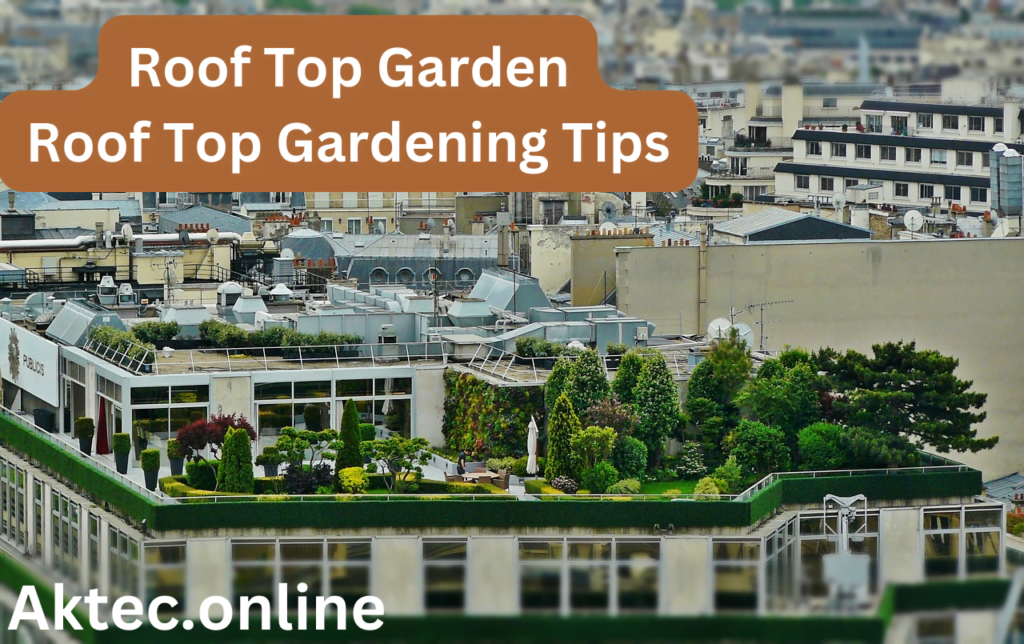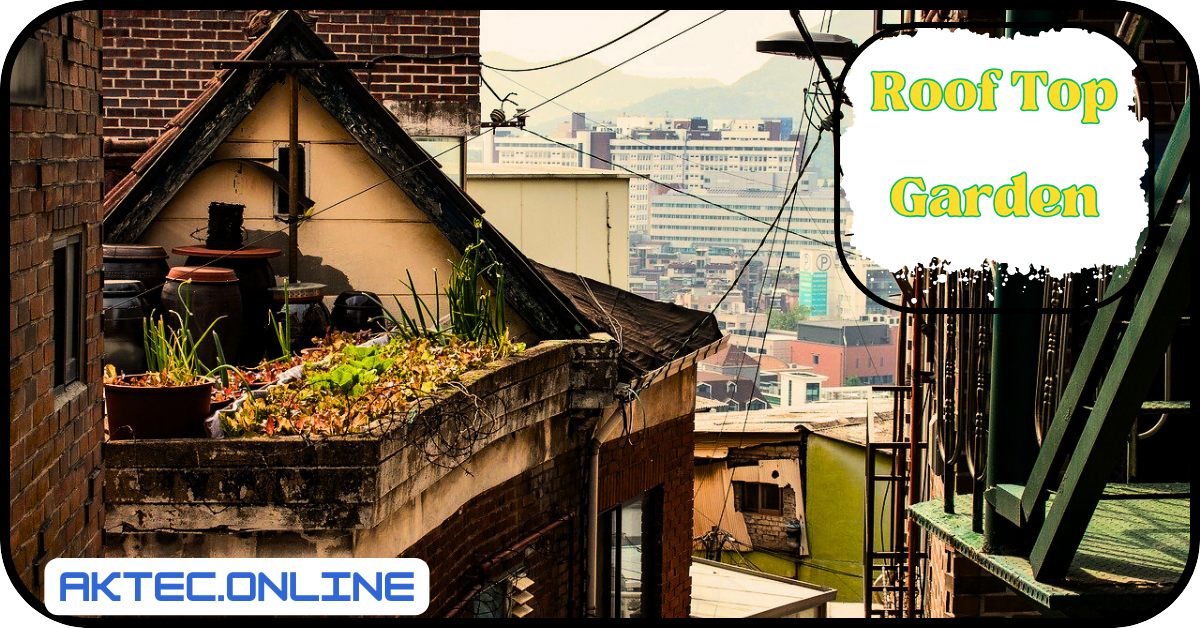
Roof Top Garden is a verdant sanctuary established on the rooftop of a building. These urban paradises not only enhance the aesthetics of your space but also boast a multitude of environmental and personal benefits.
Transform Your Rooftop into a Flourishing Oasis: A Guide to Rooftop Gardens
Rooftop gardens are not just a trend; they’re a transformative approach to urban living. A rooftop garden is a landscaped area built on the top of a building, offering a unique blend of beauty, functionality, and environmental benefits.
Rooftop gardens can cater to your desires, whether you’re seeking a tranquil escape, a haven for pollinators, or even a source of homegrown vegetables. This comprehensive guide will equip you with the knowledge to plan, design, install, and maintain a thriving rooftop garden, turning your underutilized space into a vibrant green haven.
Planning and Designing Your Rooftop Paradise
Before transforming your rooftop into a flourishing rooftop garden, a crucial first step is assessing its suitability. Structural considerations are paramount. Ensure your building can handle the additional weight of a garden, including planters, soil, and mature plants. Consult a structural engineer if necessary, especially for older buildings or those with extensive rooftop renovations planned.
Sunlight exposure is another vital factor. Conduct a shade analysis throughout the day, mapping out areas with full sun, partial shade, and full shade. This will help you choose plants that thrive in the specific light conditions available on your rooftop.
When selecting your plant companions, prioritize native and drought-resistant varieties. These require less water and maintenance, thriving in most climates. Visit local nurseries or consult with gardening experts to identify plants best suited to your rooftop’s microclimate. Rooftop gardens benefit from container gardening, offering flexibility to create diverse garden sections.
Choose lightweight, weather-resistant containers that complement your overall design aesthetic. Vertical gardening techniques, like trellises and wall planters, maximize space utilization, especially on smaller rooftops. Utilize climbing plants like vines and clematis to create living walls, adding a vertical dimension to your garden and providing privacy.
Your rooftop garden shouldn’t just be aesthetically pleasing; it should be functional as well. Incorporate seating areas and pathways for relaxation and exploration. Consider comfortable benches, ottomans, or even hammocks to create a space for quiet contemplation or social gatherings. Design pathways using weather-resistant materials like pavers or gravel, ensuring they are wide enough for easy navigation.
Water features like fountains or small ponds add a touch of tranquility and attract pollinators. The gentle sound of trickling water creates a calming atmosphere, while the water itself provides a vital source of hydration for birds and butterflies. Well-designed irrigation systems ensure your plants receive adequate hydration, especially during hot summer months.
Explore drip irrigation systems for their water efficiency, delivering water directly to plant roots and minimizing evaporation. Strategic lighting creates a magical ambiance in the evenings. String lights or solar-powered lanterns add a touch of whimsy, while strategically placed spotlights can highlight specific features of your garden.
Installing and Maintaining Your Rooftop Sanctuary
Once you’ve meticulously planned your rooftop garden, it’s time to bring your vision to life. Waterproofing is essential to prevent leaks and damage to the building’s structure. Consult with a qualified contractor to ensure proper waterproofing measures are in place before installing your garden.
Select a suitable drainage system to prevent waterlogging, which can damage the roof and harm your plants. Consider lightweight drainage mats and raised planters to facilitate proper drainage. Choosing the right soil is crucial. Opt for lightweight, well-draining potting mixes specifically formulated for rooftop gardens.
These mixes often contain ingredients like perlite or pumice to improve drainage and aeration. Raised beds can be a great option for creating planting areas and improving drainage. They come in various materials like wood, metal, or plastic, allowing you to choose a style that complements your design.
Planting your rooftop garden requires careful consideration. Research proper planting techniques for your chosen plants, ensuring they are spaced appropriately for healthy growth. Group plants with similar watering needs together to simplify irrigation. Mulching helps retain moisture, suppress weeds, and regulate soil temperature.
Apply a layer of organic mulch, like shredded bark or compost, around the base of your plants. Establish a regular watering and maintenance routine, adapting it to seasonal variations. During hot summers, you may need to water your plants more frequently, while cooler months might require less frequent watering.
Throughout the year, your rooftop garden will require ongoing care. Regular pruning and trimming maintain plant health and aesthetics. Encourage bushier growth by pinching off new shoots on your plants. Be vigilant for pests and diseases, implementing organic control methods whenever possible.
Encourage beneficial insects like ladybugs and lacewings to help control pest populations naturally. Regularly monitor your irrigation system, adjusting it based on weather conditions and plant needs. During periods of heavy rainfall, you may need to adjust the irrigation settings to prevent overwatering.

Reaping the Rewards: The Benefits and Challenges of Rooftop Gardens
Improved air quality and carbon sequestration
Rooftop gardens act as natural filters, absorbing pollutants like dust and smog from the air. Plants also release oxygen through photosynthesis, contributing to improved air quality in urban areas.
Additionally, rooftop gardens help mitigate the urban heat island effect, a phenomenon where cities experience higher temperatures than surrounding rural areas. By providing shade and evapotranspiration (the release of water vapor from plants), rooftop gardens can help cool the air and create a more comfortable urban environment.
Social and economic benefits of rooftop gardens
Community engagement and green spaces in urban areas: Rooftop gardens can foster a sense of community by providing shared spaces for residents to gather and socialize. They also create vital green spaces in densely populated urban areas, offering a much-needed connection to nature for city dwellers.
Energy efficiency and reduced cooling costs
Rooftop gardens provide insulation for buildings, helping to regulate indoor temperatures and reduce reliance on air conditioning, particularly during hot summer months. This translates to lower energy consumption and cooling costs for building owners and residents.
Potential for urban agriculture and food production
Rooftop gardens can be used to grow fresh fruits, vegetables, and herbs, offering a sustainable and local source of food for urban residents. This is particularly relevant in areas with limited access to fresh produce.
Challenges and considerations for rooftop gardens
Structural limitations and safety concerns
Ensuring your building’s structure can handle the additional weight of a rooftop garden is paramount. Consult with a structural engineer to determine the weight capacity of your rooftop and any necessary reinforcements that may be required. Safety measures like proper railings and wind protection are also crucial considerations.
Maintenance requirements and costs
Rooftop gardens require ongoing maintenance, including watering, weeding, pest control, and occasional plant replacement. Factor in the time and cost commitment associated with maintaining your rooftop garden before embarking on this project.
Accessibility and potential conflicts with building regulations
Consider how you will access your rooftop garden for maintenance purposes. Ensure your chosen access method is safe and compliant with local building codes. Research and adhere to any regulations or restrictions regarding rooftop gardens in your area.
Conclusion
Rooftop gardens offer a unique opportunity to transform your urban space into a haven of beauty, functionality, and environmental responsibility. By carefully planning, designing, installing, and maintaining your rooftop garden, you can cultivate a flourishing oasis that benefits you, your community, and the environment. So, embrace the challenge, get creative, and let your rooftop blossom into a verdant sanctuary.
FAQs
Q: Is my rooftop suitable for a rooftop garden?
A: Before diving into rooftop gardening, it’s crucial to assess your rooftop’s suitability. Here are some key considerations:
Structural capacity: Consult a structural engineer to ensure your building can handle the additional weight of a rooftop garden, including planters, soil, and mature plants.
Sunlight exposure: Conduct a shade analysis to determine areas with full sun, partial shade, and full shade. This will help you choose plants that thrive in the specific light conditions available.
Waterproofing and drainage: Ensure proper waterproofing is in place to prevent leaks. A suitable drainage system is essential to avoid waterlogging, which can damage your roof and plants.
Q: What are the best plants for a rooftop garden?
A: When choosing plants for your rooftop garden, prioritize:
Native and drought-resistant varieties
These require less water and maintenance, thriving in most climates.
Container-friendly plants
Opt for plants that adapt well to container gardening, offering flexibility in design.
Vertical gardening options
Utilize climbing plants and vining varieties to create living walls and maximize space, especially on smaller rooftops.
Q: How much maintenance does a rooftop garden require?
A: Rooftop gardens require ongoing maintenance, including:
Watering
Regular watering is crucial, especially during hot summer months. Drip irrigation systems can be a water-efficient option.
Weeding and pest control
Regular monitoring and organic control methods are recommended for weeds and pests.
Pruning and trimming
Regular pruning maintains plant health and aesthetics.
Seasonal care
Adjust watering and maintenance routines based on seasonal variations.
Q: What are the benefits of having a rooftop garden?
A: Rooftop gardens offer a multitude of benefits, including:
Environmental benefits
They act as natural filters, improve air quality, reduce stormwater runoff, and mitigate the urban heat island effect.
Social and economic benefits
They create green spaces, foster community engagement, improve energy efficiency, and offer potential for urban agriculture.
Q: What are the challenges of having a rooftop garden?
A: While rewarding, rooftop gardens come with challenges:
Structural limitations
Ensuring your building can support the weight is crucial.
Maintenance requirements
Factor in the time and cost commitment for ongoing maintenance.
Accessibility and regulations
Consider safe access methods and adhere to local building codes and regulations.
By carefully planning and addressing these considerations, you can create a thriving rooftop garden that enhances your urban space and contributes to a greener tomorrow.









